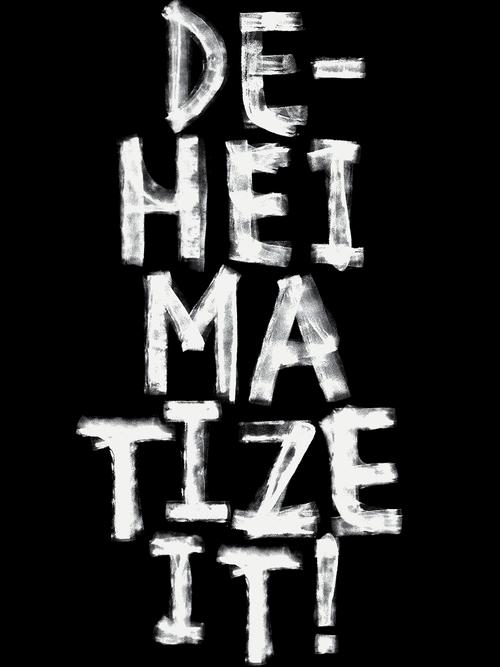De-Heimatize Exhibition
De-Heimatize Exhibition

The 4. Berliner Herbstsalon adopts Bilgin Ayata’s call and claims »De-heimatize it!« in order to oppose the strengthening of nationalist movements and the resulting backlash in the distribution of roles between gender and origin. The Herbstsalon has invited artists to dissect and dispel, bend and reshape the myths of patriarchy from different perspectives, backgrounds and motifs.
with LOLA ARIAS, CHIARA BALDINI / RAFAEL KOZDRON, YAEL BARTANA, MEHTAP BAYDU, LUCHEZAR BOYADJIEV,CANDICE BREITZ, BANU CENNETOĞLU, DANICA DAKIĆ, SILVINA DER-MEGUERDITCHIAN, LEA DRAEGER, ATOM EGOYAN, ENDER / KOLOSKO, REGINA JOSÉ GALINDO, MARTA GÓRNICKA, ANKE HANNEMANN *, SANJA IVEKOVIĆ, ALFREDO JAAR, ŠEJLA KAMERIĆ, NATASHA A. KELLY, GRADA KILOMBA, KATARZYNA KOZYRA, DAMIAN LE BAS, DELAINE LE BAS, ALANNA LOCKWARD, MARÍA PAULA MALDONADO *, HAKAN SAVAŞ MICAN, DONNA MIRANDA, HENRIKE NAUMANN, JULIETA ORTIZ DE LATIERRO *, TANJA OSTOJIĆ, CEYLAN ÖZTRÜK, YAEL PERI *, ELENA QUINTARELLI, OLIVER RESSLER / MARTIN KRENN, LARISSA SANSOUR / SØREN LIND, FARZANE VAZIRITABAR *, VIRON EROL VERT, CLAIRE WAFFEL *, INA WEISE *
* MFA-PUBLIC ART AND NEW ARTISTIC STRATEGIES DER BAUHAUS-UNIVERSITÄT WEIMAR
This year’s exhibition is based on intersectional perspectives, meaning artistic positions dealing with the various mechanisms of exclusion and inequality with regard to race, class and gender. The exhibition as a whole understands itself as a project of solidarity, as a large juncture at which the themes and conflicts converge and can be viewed and understood as such.
The path leads from a feminist-antinational examination of the choral »we« to a critical questioning of the toxic-male view of the body and finally into the history of the suppression
of non-white knowledge and narrative. Traces of structural racist and sexist violence in political and social contexts, in the media and in language thereby become visible in different ways. The intersections, however, do not only result from the spatial and thematic variation of perspectives, but also in a temporal dimension. Many of the works deal with the transmission of myths and the question of historiography, suppressed and repressed history in art and politics, and possible counter-projects. Thus, intersections repeatedly emerge between the spaces, serving as impulses for breaking up the prescribed paralysis and the desire for a new common language.
Daily free guided tours through the exhibition at Palais am Festungsgraben
Monday – Friday 4 pm, Saturday 1 pm, Sunday 1 pm and 4 pm
ADDITIONAL GUIDED TOURS:
27/October, 4pm in Spanish
02/November, 1pm in Turkish
03/November, 4pm in Turkish
09/November, 1pm in English
10/November, 4pm in Italian
16/ November, 1pm in Farsi
17/November, 4pm in Russian
27/Oktober – 17/November
12:00 – 22:00
FREE ADMISSION
Exhibitions take place at :
Maxim Gorki Theater
Mon-Fr 16:00–22:00, Sat+Su: 12:00–22:00
Palais am Festungsgraben
Mon-Fr 16:00–22:00, Sat+So: 12:00–22:00
Zeughaus
27.10.-10.11.: daily 16:00–18:00
Haus der Statistik
3.11.: Performance 16-22:00,
4.–17.11. – Installation Mo-Fr 16:00–22:00, Sat+So: 12:00–22:00
Scotty e.V.
from 30.10. daily16:00–20:00
Oranienplatz
from 30.10., 17:00